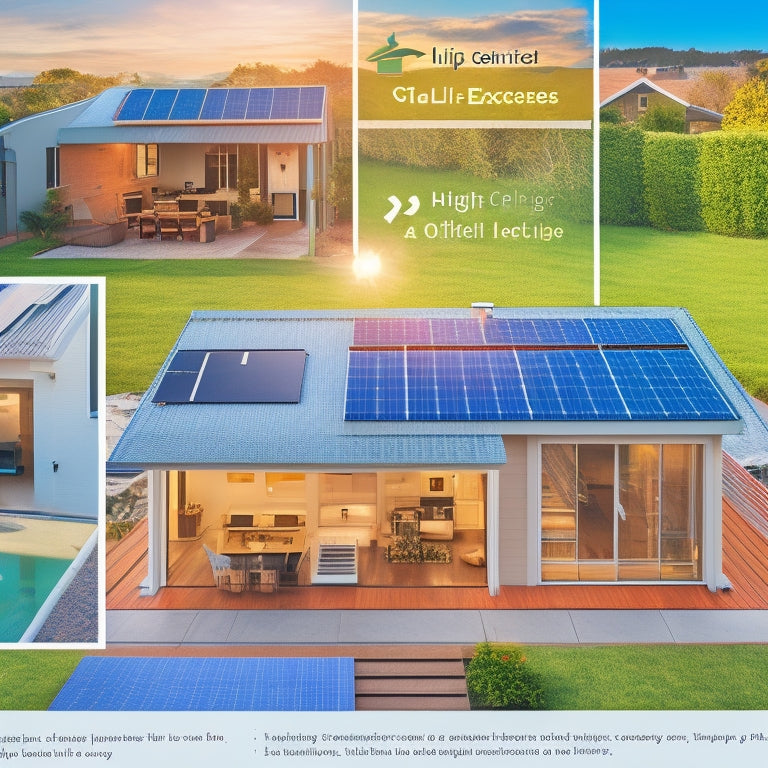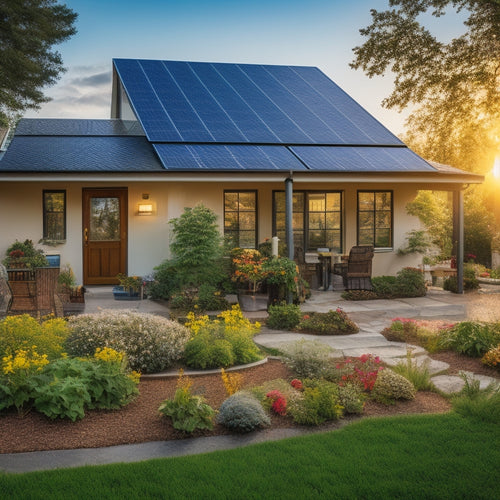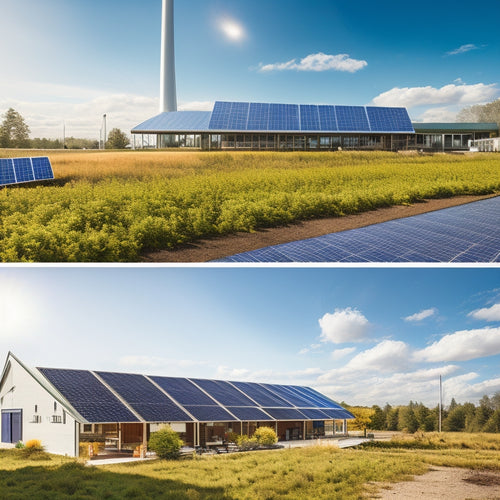
What Are the Essential Expenses in the Cost to Purchase Solar Panels
Share
When calculating the cost to purchase solar panels, you'll need to take into account nine vital expense categories. These include solar panel hardware costs, such as panel type and durability; installation labor expenses, which range from $2,000 to $5,000 or more; permits and inspection fees; roof assessment and repairs, which can cost up to $15,000; mounting and tracking systems; inverter and monitoring costs; electrical upgrades and wiring; battery storage system costs; and sales tax and rebates. Understanding these expenses is essential for an accurate estimate - and getting the most out of your investment requires a closer look at each of these factors.
Key Takeaways
- Solar panel hardware costs vary based on panel type, efficiency, durability, and warranty, with higher-efficiency panels generating more power at a higher cost.
- Installation labor expenses range from $2,000 to $5,000 or more, depending on system size and installation complexity, and require qualified installers.
- Permit and inspection fees, including necessary permits and multiple inspections, can add $100 to $800 to the overall cost.
- Additional expenses include roof assessment and repairs, mounting and tracking systems, inverter and monitoring costs, electrical upgrades and wiring, and battery storage system costs.
- Sales tax, federal tax credits, state and local rebates, and additional incentives can impact the total cost, with some incentives reducing the overall expense.
Solar Panel Hardware Costs
Your solar panel system's hardware costs encompass the expense of the photovoltaic (PV) panels themselves, which convert sunlight into electricity. These costs vary depending on the type and quality of solar panels you choose.
There are three main types of solar panels: monocrystalline, polycrystalline, and thin-film. Monocrystalline panels are the most efficient, with efficiency ratings up to 22%, but they're also the most expensive. Polycrystalline panels are less efficient, with ratings up to 18%, but are more affordable. Thin-film panels are the least efficient, with ratings up to 14%, but are the cheapest.
When selecting a solar panel type, consider your energy needs and budget. Higher-efficiency panels may be more expensive upfront, but they'll generate more power per hour of sunlight. Lower-efficiency panels may be more cost-effective, but they'll require more panels to produce the same amount of power.
Additionally, consider the warranty and durability of the panels, as well as the quality of the manufacturer. By choosing the right solar panel type and quality, you'll guarantee a reliable and efficient energy source for years to come.
Installation Labor Expenses
Once you've selected the right solar panels for your energy needs and budget, it's time to contemplate the labor costs associated with installing them.
Installation labor expenses are a critical component of the overall cost to purchase solar panels. These costs vary depending on the complexity of the installation, the size of the system, and the labor qualifications of the installation team.
You'll want to confirm that your installation team has the necessary knowledge and experience to handle the job efficiently. Look for installers with certifications from reputable organizations, such as the North American Board of Certified Energy Practitioners (NABCEP).
These certifications assure that the installers have the knowledge and skills to implement advanced installation techniques, guaranteeing a safe and efficient installation.
Labor costs can range from $2,000 to $5,000 or more, depending on the size of the system and the installation complexity.
Be sure to get quotes from multiple installers and ask about their labor qualifications, installation techniques, and warranties. This will help you make an informed decision and confirm that your solar panel system is installed correctly and efficiently.
Permits and Inspection Fees
Before commencing the solar panel installation, you'll need to obtain necessary permits and undergo inspections to confirm compliance with local building codes and regulations.
This process involves submitting a permit application to your local government, which will review your installation plan to confirm it meets their requirements. The permit application fee varies by jurisdiction, but you can expect to pay between $100 to $500.
Once your permit is approved, you'll need to schedule an inspection with a certified inspector.
The inspection process typically involves a visual examination of the installed solar panels to verify they meet safety and electrical standards. The inspector will check the wiring, connections, and mounting system to confirm they're secure and compliant with local codes.
The inspection fee ranges from $100 to $300, depending on the complexity of the installation and the inspector's rates. Be prepared to pay for multiple inspections if the initial inspection reveals any defects or non-compliant components.
These permits and inspection fees are essential expenses in the cost to purchase solar panels, as they confirm a safe and compliant installation.
Roof Repair or Replacement
Solar panel installation often requires a thorough assessment of your roof's condition, as it will be bearing the weight of the panels.
You'll need to verify your roof can support the additional load and withstand various weather conditions. A damaged or worn-out roof can compromise the solar panel's performance and longevity.
You may need to repair or replace your roof before installing solar panels, especially if it's old or shows signs of wear. This expense can add up quickly, but it's crucial to confirm the structural integrity of your roof.
A typical roof repair or replacement can cost between $5,000 to $15,000 or more, depending on the size of your roof, materials, and labor costs.
Keep in mind that a new roof usually comes with a warranty, which can give you peace of mind and protect your investment.
Additionally, a sturdy roof can help extend the solar panel longevity, guaranteeing you get the most out of your solar panel system.
Factor in these costs when calculating the total expense of your solar panel installation to get an accurate estimate.
Mounting and Tracking Systems
Most solar panel installations require a mounting system to secure the panels to your roof or ground. This system guarantees the panels are angled correctly to maximize energy production and withstand environmental elements. You'll need to decide between two primary mounting techniques: roof-mounted and ground-mounted systems.
| Mounting Technique | Description |
|---|---|
| Roof-Mounted | Attached directly to your roof, ideal for residential installations |
| Ground-Mounted | Installed on the ground, often used for larger commercial or agricultural projects |
Tracking technology can further optimize energy production by adjusting the panel's angle throughout the day. This technology can increase energy output by up to 45%. When considering tracking technology, you'll need to decide between single-axis and dual-axis tracking systems.
| Tracking Technology | Description |
|---|---|
| Single-Axis | Tracks the sun's movement east to west |
| Dual-Axis | Tracks the sun's movement east to west and north to south |
Both mounting techniques and tracking technology will impact the overall cost of your solar panel installation. It's crucial to weigh the benefits of each option against your budget and energy goals.
Inverter and Monitoring Costs
As you've considered the mounting and tracking systems for your solar panel installation, it's now time to turn your attention to the inverter and monitoring components that will convert and track the energy produced.
The inverter plays a vital role in converting DC power generated by your solar panels into AC power usable in your home. You'll want to prioritize inverter efficiency, as it directly affects the amount of energy you can utilize. Look for high-efficiency inverters (above 95%) to maximize your energy output.
In addition to the inverter, you'll need monitoring software to track your energy production in real-time. This software provides important revelations into your system's performance, helping you identify potential issues and optimize energy output.
When selecting monitoring software, consider features like data analytics, remote monitoring, and customizable alerts. These features will help you stay on top of your energy production and guarantee your system operates at peak performance.
Be prepared to budget around $1,000 to $2,000 for a high-quality inverter and monitoring system.
Electrical Upgrades and Wiring
Your electrical panel's capacity to handle the increased power output from your solar array is essential. If your existing panel is outdated or under-sized, you may need to upgrade it to guarantee safe and efficient energy transmission. This upgrade can cost between $1,000 to $3,000, depending on the complexity of the job and the type of panel required.
In addition to the electrical panel upgrade, you may need to replace your existing wiring to verify it can handle the increased power output. This is particularly important if your home has outdated wiring materials that aren't compatible with modern solar panels.
You'll want to confirm that your wiring is designed for grid compatibility, allowing you to feed excess energy back into the grid and offset your energy bills.
The cost of wiring upgrades can vary widely, depending on the extent of the work required. On average, you can expect to pay between $2,000 to $5,000 for a thorough wiring upgrade.
When selecting wiring materials, look for high-quality, durable options that are designed specifically for solar installations.
Battery Storage System Costs
One essential aspect of your solar panel system is the battery storage system, which enables you to store excess energy generated during the day for later use. This system is vital for providing power during the night or when the grid is down.
You'll need to evaluate the cost of the batteries themselves, as well as the associated components, such as inverters and monitoring systems. The type and quality of batteries you choose will greatly influence the overall cost. For example, lithium-ion batteries are more expensive than lead-acid batteries, but they offer longer battery life and lower maintenance costs.
The cost of a battery storage system can range from $5,000 to $15,000 or more, depending on the size and type of system you need.
You'll also need to assess the cost of installation, which can add another $2,000 to $5,000 to the total. Additionally, you'll need to factor in the cost of replacement batteries, which can range from $1,000 to $3,000 every 10-15 years, depending on the type and quality of the batteries.
Sales Tax and Rebates
While installing a solar panel system, you'll need to factor in sales tax and rebates, which can greatly impact your overall costs. Sales tax implications vary by state, but you can expect to pay between 4% to 8% of the total system cost. This adds up quickly, so it's crucial to take these costs into account in your budget.
However, there's a silver lining: rebates can help offset these expenses. To maximize your savings, you'll need to understand rebate eligibility and the application process.
Here are some key points to keep in mind:
- Federal Solar Investment Tax Credit (ITC) allows you to claim 26% of the total system cost as a tax credit
- State and local governments offer additional rebates, which can range from $500 to $2,000
- Utility companies may provide rebates for installing solar panels, especially if you're switching from traditional energy sources
- Non-profit organizations, like the National Renewable Energy Laboratory, offer grants and incentives for solar installations
- Your solar panel installer may offer exclusive rebates or discounts, so be sure to ask about these during the consultation process
Frequently Asked Questions
Can I Install Solar Panels on a Rented Property?
You can't install solar panels on a rented property without permission, but you can investigate a solar lease or negotiate with your landlord to discuss tenant rights, ensuring a mutually beneficial agreement that suits both parties' interests and power needs.
Do Solar Panels Work During a Power Outage?
During a power outage, you'll need a solar panel system with a battery backup or grid tie inverter to maintain power; otherwise, solar panels won't function, as they require a connection to the grid for peak solar panel efficiency, highlighting the importance of power outage solutions.
How Long Does a Solar Panel Installation Take?
You'll find that a solar panel installation typically takes 3-5 days, but the overall project timeline can stretch to 3-6 months, depending on the complexity of the installation and the efficiency of project coordination, which you'll want to oversee closely.
Can I Finance My Solar Panel Purchase?
You're likely aware that 85% of solar customers finance their systems; you can too, with various solar loan options offering financing benefits like low interest rates and flexible repayment terms, making your solar dream more accessible.
Will Solar Panels Increase My Property Value?
You'll experience significant property appreciation as solar panels enhance your home's value, providing investment benefits that'll pay off in the long run; in fact, studies show that solar-powered homes sell for up to 17% more than non-solar counterparts.
Conclusion
As you commence your solar panel expedition, remember that the total cost is more than just the sticker price of the panels themselves. You'll need to factor in the essential expenses outlined above, from hardware and installation to permits and electrical upgrades. It's like buying a time machine - you're investing in a brighter future, but you need to fuel it with a solid understanding of the costs involved. By doing your due diligence, you'll be utilizing the power of the sun in no time.
Related Posts
-

Solar Energy Benefits for Sustainable Living
Solar energy provides numerous benefits for sustainable living that you can't overlook. By switching to solar, you'll...
-

How to Achieve Energy Independence at Home
To achieve energy independence at home, start by investing in renewable energy sources like solar panels, wind turbin...
-

Off-Grid Solar Solutions for Eco-Conscious Businesses
Off-grid solar solutions offer you a path to both sustainability and substantial cost savings. By adopting these syst...


